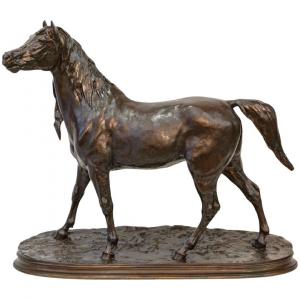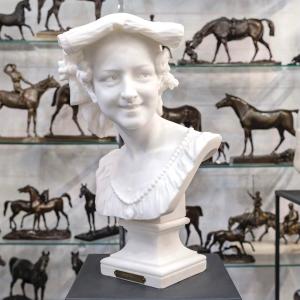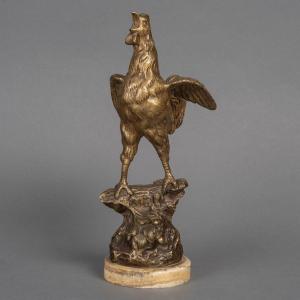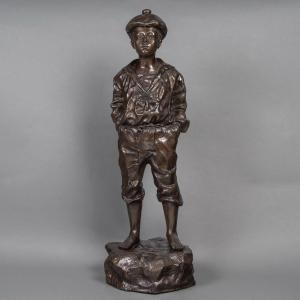The nudity of the boy's body indicates that the scene is set in antiquity .
His foot and hand are suspended in the air , as if the boy were fixed in a victorious dance step .
The fighting rooster is in the right arm of the young man , his head is straight , which shows his conquering temperament .
The sculpture shows the moment following the fight : the presentation of the "Winning Rooster" which brings recognition and money from the bettors to the breeder of the animal .
Bronze proof with nuanced brown patina , resting on a red marble base .
Signature of the sculptor "A.Falguière" , hollow , on the oval terrace , naturalist .
Circular foundry stamp "Thiébaut Frères" .
Old edition bronze .
Period second part of the 19th century .
Very good state of preservation and patina .
The Thiébaut Frères foundry was one of the most important Art foundries in France during the 19th and 20th centuries .
Their achievements are visible all over the world .
Particularly present in France , Thiébaut Frères fonts adorn dozens of squares and gardens in Paris , including Place de la République , Place de la Nation and Place Vendôme ...
Alexandre Falguière (1831-1900)
Trained in the studio of the sculptor François Jouffroy at the École des Beaux-Arts in Paris , Alexandre Falguière won "The Rome Prize" in 1859 , which enabled him to receive a government scholarship to study at the Villa Medici in Rome .
In 1864 , he sent to the Salon des Artistes , which is held every year in Paris , the fruit of his Italian work , the sculpture of the "Winner In Cockfight" .
The success is immediate .
Emperor Napoleon III , buys the original bronze sculpture .
It measures one meter seventy-four and is kept at the Orsay Museum .
Numerous editions were then melted down to satisfy the demands of collectors .
Their sizes vary from 40 to 90 centimeters in height .
The sale of these sculptures provides Alexandre Falguière with a comfortable income , and places him in the position of prominent artist .
Falguière was then part of a group of sculptors , with Dubois , Mercié and Moulin , who were nicknamed the " Florentines ".
As in the city of Florence during the Renaissance , these sculptors draw their themes from antiquity .
They are also inspired by bronzes rediscovered in the ruins of Pompeii , reproductions of which circulate through Europe .
The sculpture is part of the emerging movement of the neo-Florentines .
References to the Renaissance , notably to the juvenile male figures of the sculptor Donatello , mingle with the classical inspiration of the subject .
The work was presented again at the Universal Exhibitions of 1867 and 1889 .












































 Le Magazine de PROANTIC
Le Magazine de PROANTIC TRÉSORS Magazine
TRÉSORS Magazine Rivista Artiquariato
Rivista Artiquariato